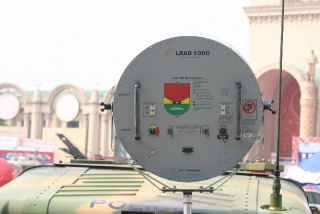Weapons exports to China are of course illegal, after a law passed in the aftermath of the Tiananmen Square massacre. However, As I report in New Scientist, LRAD is not classed as a weapon.
We have seen similar devices used elsewhere – Danger Room reported on an incident last year in Tbilisi in the former Soviet Union ("Georgia Police Turns Sonic Blaster on Demonstrators") and in a TV news clip a local weapons expert describes it as "an acoustic gun." However, although many Western media describe LRAD as weapon –especially after it was used to repel Somali pirates in 2006 – the makers stick to calling it a "device." Sharon looked at the distinction in DR last year (Acoustic "Device" or Acoustic Weapon?") and noted then that not calling it a weapon was a strategic move to avoid "politically charged debates."
In any case, there is nothing like LRAD on the State Department's Munitions list, so for legal purposes it is not considered a weapon. Which means its maker can openly announce the LRAD's export to China. But it would be ironic to say the least if free speech protesters at this year's Beijing Olympics were drowned out or driven off by police wielding American technology.
Carl Gruenler, (former) vice president of military and government operations for American Technology Corp. (and who now runs a company making a competing device), says that being within 100 yards (90 m) of the device is extremely painful, but its use should be limited to 300 yards (270 m) to be effectively used. He concedes that the device is powerful enough to cause permanent auditory damage, but that it is only meant to be used for a few seconds at a time.
ALSO:
- I Was a Sonic Blaster Guinea Pig
- Acoustic "Device" or Acoustic Weapon?
- Sonic Blaster Nails Me
- Lab Pushes for Sonic Blaster
- New Sonic Blaster Ready to Scream
- Sonic Blaster + Laser = New Weapon
- Critics Attack Sonic Youth Blaster
- Anti-Teen Weapon Comes to New York
- Sonic Blaster Makers Rebuffed
- Georgia Police Turns Sonic Blaster on Demonstrators
- Where's My Acoustic Bazooka?


